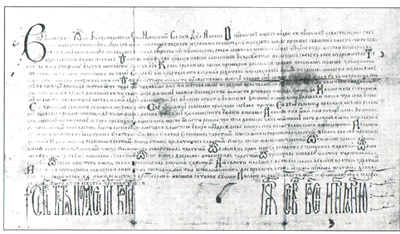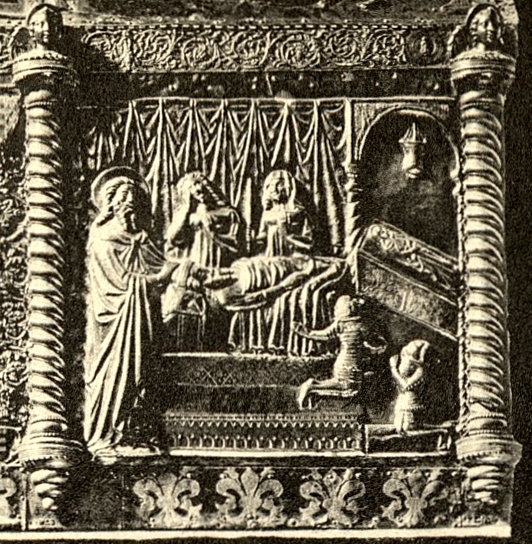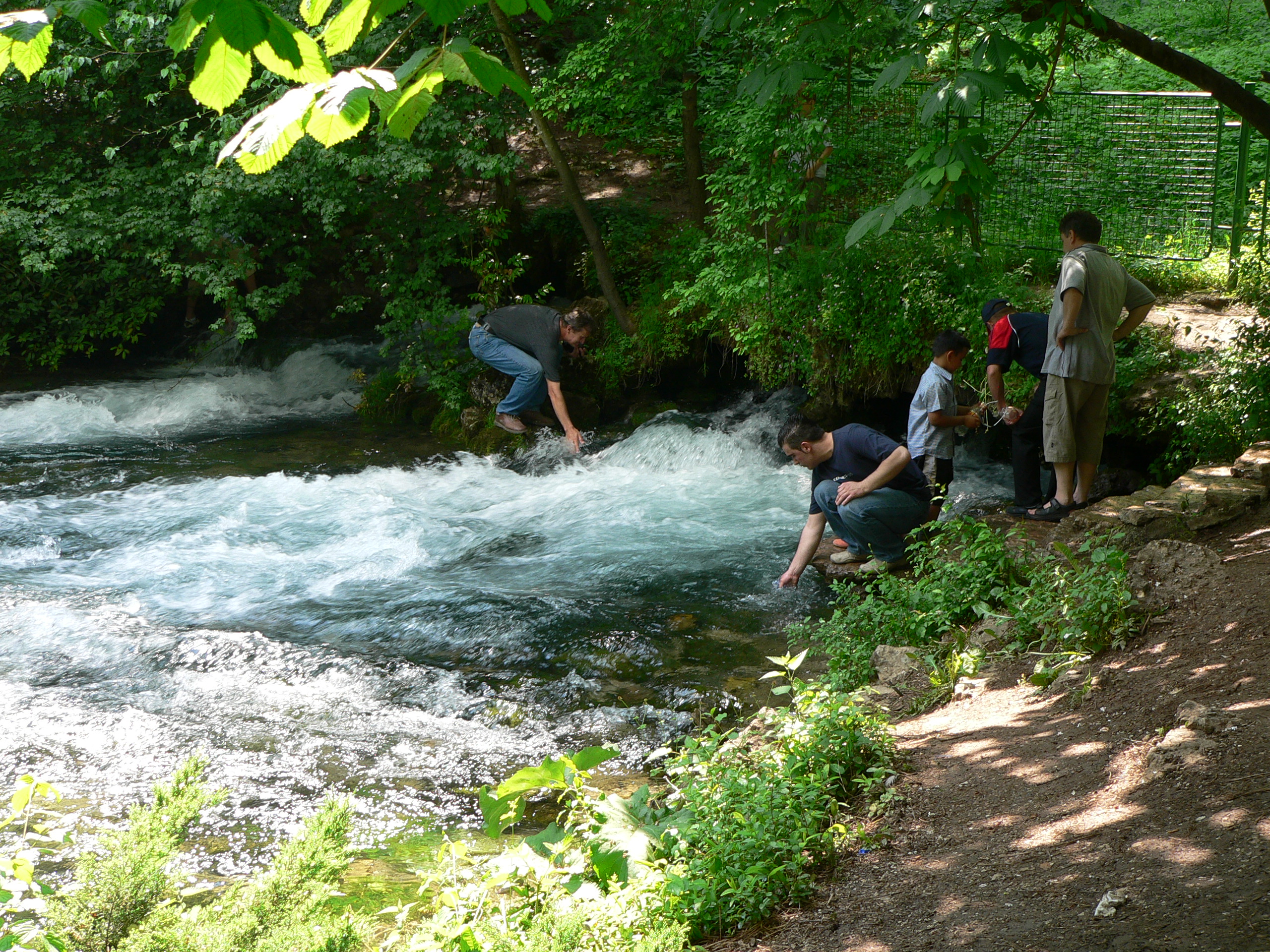|
Visoko
Visoko ( sr-cyrl, Високо, ) is a city located in the Zenica-Doboj Canton of the Federation of Bosnia and Herzegovina, an entity of Bosnia and Herzegovina. As of 2013, the municipality had a population of 39,938 inhabitants with 11,205 living in Visoko town. Located between Zenica and Sarajevo, Visoko lies where the river Fojnica joins the Bosna. The Visoko region has evidence of long continuous occupation, with the first traces of life dating back to the 5th millennium BC. Archaeological excavations of Okolište have found one of the biggest neolithic settlements of the Butmir culture in southeastern Europe. It was an early political and commercial center of the Bosnian medieval state, and the site where the first Bosnian king Tvrtko I was crowned. The Old town Visoki, located on Visočica hill, was a politically important fortress, and its inner bailey Podvisoki was an early example of a Bosnian medieval urban area.Pavao Anđelić, Srednji vijek – Doba stare bosan ... [...More Info...] [...Related Items...] OR: [Wikipedia] [Google] [Baidu] |
Visoko During The Middle Ages
The area of today's Visoko is considered to be a nucleus from where Bosnian statehood was developed in 10th century. The expanded valley of the river Bosna around today's Visoko was the biggest agriculture area in central Bosnia, so fertile ground around Visoko was ideal for development of early political center of Bosnian nobility. The settlement that was in Visoko field has been associated with name Bosnia for a long time, only since the 1350s has the name Visoki became widely used. Visoko and its valley with Mile, Moštre, Podvisoki was an early center of the Bosnian medieval state, and the site where the first Bosnian King Tvrtko I was crowned. The old town of Visoki, located on Visočica hill, was a politically important fortress, and its inner bailey, Podvisoki, was an early example of a Bosnian medieval urban area.Pavao Anđelić, Srednji vijek – Doba stare bosanske države, "Visoko i okolina kroz historiju I, Visoko 1984, 160–162 History Medieval settlement Bos ... [...More Info...] [...Related Items...] OR: [Wikipedia] [Google] [Baidu] |
Old Town Of Visoki
The Old town of Visoki ( sh-Latn-Cyrl, Stari grad Visoki, Стари град Високи, ) was a medieval royal castle town built during the 14th century on the top of the hill overlooking town of Visoko, Bosnia and Herzegovina. The first mention of the town was on 1 September 1355, in the charter "''in castro nosto Visoka vocatum''" written by Tvrtko I of Bosnia while he was a young ban. The town was presumably abandoned before 1503, as it is not mentioned in the Turkish-Hungarian treaty from the mentioned year. In 1626, Đorđić mentioned Visoki among abandoned towns. Location and size The Old Town of Visoki is at the top of Visočica hill, high. Its position provides an excellent view at the plains below. The entry to the castle is on the southwest side, with two lookout towers. Passing through the entry you enter a part that is called ''Podvisoki'', which was quite small, measuring and has signs and remains of early medieval houses. The thickness of the castle town w ... [...More Info...] [...Related Items...] OR: [Wikipedia] [Google] [Baidu] |
Podvisoki
Podvisoki ( cyrl, Подвисоки) was a medieval settlement, a castle town (in ), as part of wider area just beneath of the fortress Visoki, located on the Visočica hill above modern-day Visoko, Bosnia and Herzegovina. History Podvisoki was main trading center over course much of the history of Bosnian medieval state from the mid 14 century. The first direct mention was in 1363. It was located along river Fojnica, in the foothills of Visočica hill, Visoko. Podvisoki was one of the early examples of medieval urban settlement in Bosnia region. Podvisoki had a colony of Ragusan merchants. They remained there until 1430s, when they moved to Fojnica. Notable local merchant from Visoko in 14th century was Milaš Radomirić. Ragusan sources cite biggest caravan trade between Podvisoki and Ragusa in 1428. That year, on 9 August, Vlachs committed to Ragusan lord Tomo Bunić, that they will with 600 horses deliver 1500 modius of salt. Delivery was meant for Dobrašin Veseoković, ... [...More Info...] [...Related Items...] OR: [Wikipedia] [Google] [Baidu] |
Pavao Anđelić
Pavao Anđelić (1920-1985) was a Bosnian lawyer, archaeologist and historian. He mainly studied the history of medieval Bosnia and is noted for archeological work done at Mile and historically rich areal surrounding modern town of Visoko, as well as Kraljeva Sutjeska and Bobovac. He was born in Sultići, Konjic. Completed Franciscan gymnasium in Visoko and later law in Zagreb, studied history in Sarajevo. He worked in Institute for the Protection of Cultural Monuments in Sarajevo, and was higher custodian in the National Museum of Bosnia and Herzegovina in Sarajevo until his retirement. Achieved doctorate at University of Belgrade Faculty of Philosophy The University of Belgrade Faculty of Philosophy ( sr, Филозофски факултет Универзитета у Београду), established in 1838 within the Belgrade Higher School, is the oldest Faculty at the University of Belgrade .... His archaeological research was concentrated at royal court sites of medieval ... [...More Info...] [...Related Items...] OR: [Wikipedia] [Google] [Baidu] |
Mile (Visoko)
Mile ( cyrl, Миле) located in the Visoko basin was a medieval crowning and burial place of Bosnian kings during the Kingdom of Bosnia (13771463). Mile is a protected national monument of Bosnia and Herzegovina. History Mile held a great importance for Bosnian nobility, and was one of the places for Stanak, the most common name used to refer to the assembly of nobility in medieval Bosnia. From 1367 to 1407 several historical sources mention Ragusan merchants who gave money contributions for the Franciscan friary that was located in Mile, which is, according to sources from 1380 to 1390, identified as Stephen II Kotromanić ban's foundation, the Franciscan friary of Saint Nicholas of the Little Brothers. Mile was first mentioned (in written sources: Mile, Sv. Nikola, Visoko, Mileševo) in 1244, as a place of church of Saint Kuzma and Damjan. The same year, Stephen II Kotromanić built the first Franciscan friary of Saint Nicholas. Mile was the crowning place of Bosnian king ... [...More Info...] [...Related Items...] OR: [Wikipedia] [Google] [Baidu] |
Tvrtko I
Stephen Tvrtko I ( sh-Latn-Cyrl, separator=" / ", Stjepan/Stefan Tvrtko, Стјепан/Стефан Твртко; 1338 – 10 March 1391) was the first king of Bosnia. A member of the House of Kotromanić, he succeeded his uncle Stephen II as Ban of Bosnia in 1353. As he was a minor at the time, Tvrtko's father, Vladislav, briefly ruled as regent, followed by Tvrtko's mother, Jelena. Early in his personal rule, Tvrtko quarreled with his country's Roman Catholic clergy, but later enjoyed cordial relations with all the religious communities in his realm. After initial difficulties – the loss of large parts of Bosnia to his overlord, King Louis I of Hungary, and being briefly deposed by his magnates – Tvrtko's power grew considerably. He conquered some remnants of the neighbouring Serbian Empire in 1373, after the death of its last ruler and his distant relative, Uroš the Weak. In 1377, he had himself crowned king of Bosnia and of Serbia, claiming to be the heir of Serbia' ... [...More Info...] [...Related Items...] OR: [Wikipedia] [Google] [Baidu] |
Bosnian Medieval State
This is the history of Bosnia and Herzegovina in the Middle Ages, between the ancient and Roman period and the Ottoman period. Early Middle Ages The western Balkans had been reconquered from "barbarians" by Byzantine Emperor Justinian (r. 527–565). Sclaveni (Slavs) raided the Western Balkans, including Bosnia, in the 6th and 7th century. According to ''De Administrando Imperio'' written in 10th century, these were followed by Croats and Serbs who arrived in the late 620s and early 630s, the Croats invited by Emperor Heraclius to fend off an invasion by the Pannonian Avars, and both had by this time settled West and East of Bosnia. Croats "settled in area roughly corresponding to modern Croatia, and probably also including most of Bosnia proper, apart from the eastern strip of the Drina valley" while Serbs "corresponding to modern south-western Serbia (later known as Raška), and gradually extended their rule into the territories of Duklja and Hum". Early medieval polity ... [...More Info...] [...Related Items...] OR: [Wikipedia] [Google] [Baidu] |
Bosnia And Herzegovina
Bosnia and Herzegovina ( sh, / , ), abbreviated BiH () or B&H, sometimes called Bosnia–Herzegovina and often known informally as Bosnia, is a country at the crossroads of south and southeast Europe, located in the Balkans. Bosnia and Herzegovina borders Serbia to the east, Montenegro to the southeast, and Croatia to the north and southwest. In the south it has a narrow coast on the Adriatic Sea within the Mediterranean, which is about long and surrounds the town of Neum. Bosnia, which is the inland region of the country, has a moderate continental climate with hot summers and cold, snowy winters. In the central and eastern regions of the country, the geography is mountainous, in the northwest it is moderately hilly, and in the northeast it is predominantly flat. Herzegovina, which is the smaller, southern region of the country, has a Mediterranean climate and is mostly mountainous. Sarajevo is the capital and the largest city of the country followed by Banja Luka, Tu ... [...More Info...] [...Related Items...] OR: [Wikipedia] [Google] [Baidu] |
Ajas-pasha
Ajas Pasha (? - Anatolia, 1486) was a Bosnian sanjak-bey and later pasha in Ottoman service. Career He was sanjak-bey of Bosnia, referred to as ''the Lord of the King's land'', from 1470 to 1475, 1477 to 1478 and in 1483, and ruled sanjak-bey of Herzegovina, also referred to as ''Herzegovina's Krajisnik'' or ''Duke of the Herzeg's land'', from 1478 to 1480 and 1481 to 1483. In 1472 he raided Croatian littoral, Istria and Friuli region. In November 1481 he besieged Herceg Novi, and on 14th December of 1481 he captured the city after Vlatko Hercegović gave up defending it and agreed surrender. For this he was awarded title of ''pasha''. Achievements He played a key role in the development of Visoko from a Bosnian medieval type of town to Ottoman styled urban organization. He legalized his waqf in 1477 hammam, shops, maktab, water supply system, bridge on river Bosna, madrasa and Naqshbandi khanqahVakufnama Isa-bega Ishakovića (1462.) Vakufnama Ajas-bega (1477.) Vakufnama Ha ... [...More Info...] [...Related Items...] OR: [Wikipedia] [Google] [Baidu] |
List Of Cities In Bosnia And Herzegovina
This is a list of city, cities and towns with over 10,000 inhabitants (or lower if the municipality has over 20,000 inhabitants) in Bosnia and Herzegovina. For the full list of populated places, see List of populated places in Bosnia and Herzegovina. Organization Apart from entities, cantons and municipalities, Bosnia and Herzegovina also has officially designated cities. Official cities have their own mayor and city council, which is a big difference to the municipalities of Bosnia and Herzegovina, which have a municipal council and mayor. Powers of city councils of official cities are between the government of municipalities and government cantons in the Federation of Bosnia and Herzegovina or a government entity in Republika Srpska. There are thirty two official cities in Bosnia and Herzegovina (as of 2022): *Banja Luka *Bijeljina''Službeni glasnik Republike Srpske br. 70/12'' *Bihać *Bosanska Krupa *Cazin *Čapljina *Derventa *Doboj *Goražde *Gračanica, Bosnia and He ... [...More Info...] [...Related Items...] OR: [Wikipedia] [Google] [Baidu] |
Bosna (river)
The Bosna () is the third longest river in Bosnia and Herzegovina, and is considered one of the country's three major internal rivers, along with the Neretva and the Vrbas. The other three major rivers of Bosnia and Herzegovina are the Una, to the northwest; the Sava, to the north, and the Drina, to the east. This river is the namesake of Bosnia. The river Bosna flows for . The river is possibly mentioned for the first time during the 1st century AD by Roman historian Marcus Velleius Paterculus under the name ''Bathinus flumen''. Another basic source that is associated with the hydronym ''Bathinus'' is the Salonitan inscription of the governor of Dalmatia, Publius Cornelius Dolabella, where it is said that the ''Bathinum'' river divides the Breuci from the Osseriates. And also by the name of Basante. There was also the name Bason on the map ''From Istanbul to Vienna'' along the Danube and the Black Sea — a river-centric map by the Venetian cartographer Stefano Scolari, ... [...More Info...] [...Related Items...] OR: [Wikipedia] [Google] [Baidu] |
Fojnička River
Fojnička River ( bs, Fojnička rijeka / Фојничка ријека, "Fojnica River") is a left tributary of the Bosna (river), Bosna in Bosnia and Herzegovina. It flows for 46 kilometres with a basin area of 727 km². The Željeznica (Fojnička River), Željeznica and the Lepenica (Fojnička River), Lepenica are tributaries of the Fojnička River. It is among last remaining sanctuaries for huchen (Hucho hucho) in the Bosna river basin, others being the Krivaja (Bosna), Krivaja, and possibly the Lašva and the Željeznica (Bosna), Željeznica. See also *Visoko References External links * Rivers of Bosnia and Herzegovina {{BosniaHerzegovina-river-stub ... [...More Info...] [...Related Items...] OR: [Wikipedia] [Google] [Baidu] |




